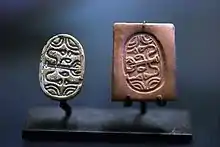Stamp seal
The stamp seal is a carved object, usually stone, first made in the 4th millennium BC, and probably earlier. They were used to impress their picture or inscription into soft, prepared clay.

Seal devices have seldom survived through time; it is usually only their impressions. A major exception are the cylinder seals made of stone, of which examples of their ancient impressions have survived as well, the majority being of clay tablets sealed as an authentication.
The Halaf culture saw the earliest known appearance of stamp seals in the Near East.[1]
Indus stamp-seal

Different from the Minoan stamp-seals, the Indus stamp-seals probably have a different function from the stamp seals of the Minoan civilization, as they typically have script characters, with still undeciphered associations.
Gallery

 Stamp seals
Stamp seals
See also
References
- Brown, Brian A.; Feldman, Marian H. (2013). Critical Approaches to Ancient Near Eastern Art. Walter de Gruyter. p. 304. ISBN 9781614510352.
- Garbini. Landmarks of the World's Art, The Ancient World, by Giovanni Garbini, (McGraw-Hill Book Company, New York, Toronto), General Eds, Bernard S. Myers, New York, Trewin Copplestone, London, c 1966. Numerous examples of the Cylinder seal; ( 3 ) separate Discussions (only) of "Stamp sealing". No seals, or impressions thereof.
- P. Yule, Early Cretan Seals: A Study of Chronology. Marburger Studien zur Vor und Frühgeschichte 4 (Mainz 1981), ISBN 3-8053-0490-0
External links
| Wikimedia Commons has media related to Stamp seals of archaeology. |
- Detail of Stamp seal-Medium Res;
- Article mcclungmuseum.utk.edu—Jar, and associated Stamp Seal
- Gazelle Head, Stamp seal – at the Oriental Institute of Chicago.